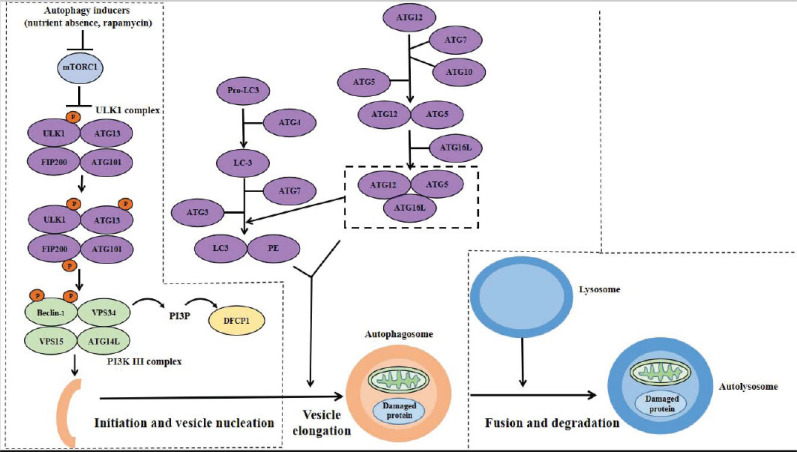Fig. (1).
Schematic illustration of the autophagy pathway. Autophagy is strictly controlled through multiple pathways. Autophagy inducer, such as nutrient absence or rapamycin, activates the ULK1 complex through phosphorylating ULK1, which leads to the activation of PI3K III complex. Activated PI3K III complex produces phosphatidylinositol 3-phosphate by VPS34. Phosphatidylinositol 3-phosphate then recruits DFCP1 to accelerate the process of vesicle nucleation. ATG12 is conjugated to ATG7, ATG10, and ATG5 in order, forming the ATG12-ATG5 conjugate with the help of ATG7 and ATG10. Combined with ATG16L, the ATG12-ATG5-ATG16L conjugate is formed. Mediated by ATG4, Pro-LC3 is converted to LC3, which is conjugated to PE by ATG3, ATG7, and ATG12-ATG5-ATG16L conjugate, forming LC3-PE conjugate. Both ATG12-ATG5-ATG16L conjugate and LC3-PE conjugate participate in the elongation of autophagosomes. After elongation, autophagosomes are fused with lysosomes forming autolysosomes, which is mediated by SNARE syntaxin 17, PLEKHM1, and Atg14. Cargos in autolysosomes are digested by lysosomal enzymes. Nutrients generated by digestion act as activators and inhibitors for mTOR and AMP-activated protein kinase (AMPK), respectively, which lead to the inactivation of ULK1 complex and termination of autophagy. Abbreviation: mTOR, mammalian target of rapamycin; ULK1, Unc-51-like kinase 1; ATG, autophagy related proteins; FIP, focal adhesion kinase family interacting protein; VPS, vacuolar protein sorting; PI3P, phosphatidylinositol-3-phosphate. (A higher resolution / colour version of this figure is available in the electronic copy of the article).

